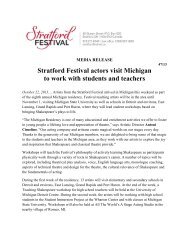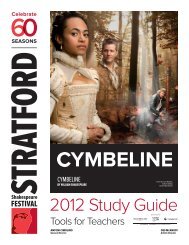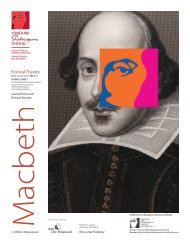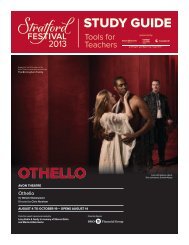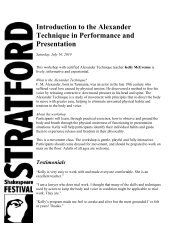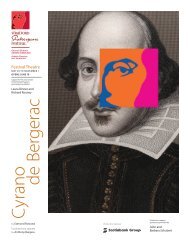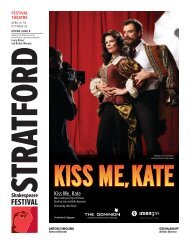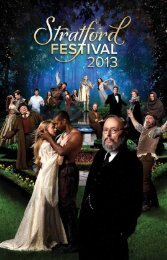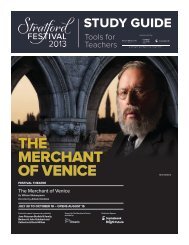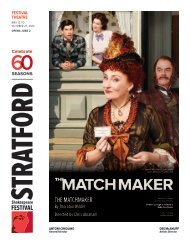MEASURE - Stratford Festival
MEASURE - Stratford Festival
MEASURE - Stratford Festival
- No tags were found...
You also want an ePaper? Increase the reach of your titles
YUMPU automatically turns print PDFs into web optimized ePapers that Google loves.
Table of ContentsThe PlaceThe <strong>Stratford</strong> <strong>Festival</strong> Story ........................................................................................ 1The PlayThe Playwright: William Shakespeare ........................................................................ 3A Shakespearean Timeline ......................................................................................... 4Cast of Characters ...................................................................................................... 6Plot Synopsis ............................................................................................................... 7Sources and Origins .................................................................................................... 8The ProductionArtistic Team and Cast ............................................................................................... 11Lesson Plans and ActivitiesThe Pageant of Vices & Virtues .......................................................................... 12Isabella’s Plea for Justice .................................................................................... 16Six Characters in Search of… ............................................................................. 21Discussion Topics ............................................................................................... 26Resources ..................................................................................................... 27
The Playwright:William ShakespeareBorn in <strong>Stratford</strong>-upon-Avon, a smallWarwickshire town, in 1564, WilliamShakespeare was the eldest son of JohnShakespeare, a glover, and Mary Arden,the daughter of a wealthy farmer. Theexact date of his birth is unknown, butbaptismal records point to it being thesame as that of his death, April 23. Heprobably attended what is now the EdwardVI Grammar School, where hewould have studied Latin literature, andat 18, he married a farmer’s daughter,Anne Hathaway, with whom he had threechildren: Susanna, born in 1583, and,two years later, the twins Hamnet (whodied in childhood) and Judith.Nothing further is known of his life until1592, when his earliest known play, thefirst part of Henry VI, became a hit in London,where Shakespeare was now workingas an actor. Soon afterwards, an outbreakof the plague forced the temporaryclosure of the theatres, and Shakespeareturned for a while to writing poetry. By1594, however, he was back in the theatre,acting with the Lord Chamberlain’sMen. He quickly established himself asone of London’s most successful dramatists,with an income that enabled him, in1597, to buy a mansion back in <strong>Stratford</strong>.In 1599 he became a shareholderin London’s newly built Globe Theatre.his death on April 23, 1616. He is buriedin the town’s Holy Trinity Church.In the first collected edition of his worksin 1623, fellow dramatist Ben Jonsoncalled him a man “not of an age, but forall time”. Not only did Shakespeare writesome of the most popular plays of alltime, but he was a very prolific writer,writing 38 (canonically accepted) worksin 23 years. His work covered manysubjects and styles, including comedies,tragedies, histories and romances, allbearing his hallmark expansive plots, extraordinarylanguage and humanistthemes. Shakespeare enjoyed great popularityin his lifetime, and 400 years later,he is still the most produced playwrightin the world.In 1603, Shakespeare’s company wasawarded a royal patent, becoming knownas the King’s Men. Possibly as early as1610, the playwright retired to his homein <strong>Stratford</strong>-upon-Avon, living there – andcontinuing to invest in real estate – untilMeasure for MeasureStudy Guide<strong>Stratford</strong> <strong>Festival</strong> 2013 3
A SHAKESPEAREAN TIMELINE1558 Elizabeth I crowned.1564 William Shakespeare born.1572 Actors not under the protection of a patron declared rogues and vagabonds.1576 “The Theatre”, the first public playhouse in London, opens.1577 “The Curtain”, London’s second playhouse, opens.1578 James VI (later James I of England) takes over government of Scotland.1579 Publication of North’s English translation of Plutarch’s Lives of the Noble Grecians andRomans.1580 Francis Drake returns in triumph form his voyage around the world; travelling players performat <strong>Stratford</strong>.1582 Shakespeare marries Anne Hathaway; Susanna is born six months later and the twinsHamnet and Judith in 1585.1587 “The Rose” theatre opens in London. Mary Queen of Scots is executed.1588 Spanish Armada defeated.1589 Shakespeare finds work as an actor in London; he lives apart from his wife for 21 years.1590-1591 The Two Gentlemen of Verona, The Taming of the Shrew.1591 2 Henry VI, 3 Henry VI.1592 Thousands die of plague in London; theatres closed. 1 Henry VI, Titus Andronicus, Richard III.1593 The Comedy of Errors.1594 Shakespeare becomes a shareholder of his theatre company, The Lord Chamberlain’s Men.1594 Love’s Labour’s Lost.1595 Richard II, Romeo and Juliet, A Midsummer Night’s Dream.1596 Shakespeare’s son, Hamnet, dies.1596-1597 King John, The Merchant of Venice, 1 Henry IV.1597-1598 The Merry Wives of Windsor, 2 Henry IV, Much Ado About Nothing.1598 “The Globe” theatre built.1598-1599 Henry V, Julius Caesar.1599-1600 As You Like It.1600-1601 Hamlet, Twelfth Night.1601 Shakespeare’s patron arrested for treason following the Essex rebellion; he is later pardoned.1602 Troilus and Cressida.1603 Queen Elizabeth dies and is succeeded by James I; Shakespeare’s theatre company becomesthe King’s Men.1603* Measure for Measure, Othello.1604 Work begins on the King James bible.1604-1605 All’s Well That Ends Well, Timon of Athens, King Lear (Q)1606 Macbeth, Antony and Cleopatra.Measure for MeasureStudy Guide<strong>Stratford</strong> <strong>Festival</strong> 2013 4
1607 Pericles, Prince of Tyre.1608 Coriolanus.1609 The Winter’s Tale.1610 King Lear (F), Cymbeline.1610 Shakespeare retires to <strong>Stratford</strong>-upon-Avon.1611 The Tempest.1611 King James version of the bible published.1613 Henry VIII (All is True), The Two Noble Kinsmen.1613 “The Globe” theatre burns down.1616 Shakespeare dies in <strong>Stratford</strong>-upon-Avon.1623 The first folio of Shakespeare’s collected plays is published.* some dates are approximateMeasure for MeasureStudy Guide<strong>Stratford</strong> <strong>Festival</strong> 2013 5
CAST OF CHARACTERSVincentio, the DukeEscalus, a lordAngelo, the DeputyLucio, friend of ClaudioMistress Overdone, a bawdPompey, the clown, servant to Mistress OverdoneClaudio, brother to IsabellaProvostFriar ThomasIsabella, sister to ClaudioFrancisca, a nunElbow, a constableFroth, a gentlemanJuliet, beloved of ClaudioMariana, betrothed to AngeloAbhorson, an executionerBarnardine, a prisonerVarrius, a lord, friend to dukeA JusticeCitizens, Servants, Nuns, Soldiers, Gentlemen, Lords, MessengerMeasure for MeasureStudy Guide<strong>Stratford</strong> <strong>Festival</strong> 2013 6
PLOT SYNOPSISVincentio, the Duke of Vienna, announces that he is going abroad and appoints theadministrator Angelo as his deputy, charging him with the task of enforcing the city’slong-neglected laws against immorality. In fact, however, the Duke remains in Vienna,disguising himself as a friar in order to observe the effects of Angelo’s crackdown.Angelo’s first act is to condemn to death a young man named Claudio, forimpregnating his betrothed, Juliet. When Claudio’s sister Isabella, a member of thenovitiate in a convent, pleads for clemency, Angelo offers her a bargain: he will saveher brother’s life if she will sleep with him. The virtuous Isabella recoils in horror fromthis proposal, even though Angelo warns her that her refusal will result in torturebeing added to Claudio’s sentence. The disguised Duke, however, comes forwardwith a plan: if Isabella will pretend to accept Angelo’s proposal, the Duke will arrangefor Mariana, a lover whom Angelo has previously spurned, to take her place undercover of darkness. When Angelo – who has planned to have Claudio executed anyway– falls for this trick, the Duke, revealing his true identity, orders him to marryMariana. Claudio is freed, and the Duke declares his love for Isabella.Visit the <strong>Stratford</strong> <strong>Festival</strong>’s YouTube channel for behind-the-scenes videos, photos andinterviews: www.youtube.com/user/stratfordfestivalYou can also check out the <strong>Stratford</strong> <strong>Festival</strong>’s Flickr pages for photos:www.flickr.com/photos/stratfest/Both of these sites are updated throughout the season.Measure for MeasureStudy Guide<strong>Stratford</strong> <strong>Festival</strong> 2013 7
The Story of the PlaySources and Production HistoryABOUT THE PLAYWritten during the spring or summer of 1604, Measure for Measure is the last ofShakespeare’s comedies. Along with Troilus and Cressida (c. 1602) and All’s Well That EndsWell (c. 1604), it is sometimes referred to as one of Shakespeare’s “problem plays”: satiricaland thought-provoking works that invite ambivalent responses to the characters andsituations they present.Measure for Measure was first published in the First Folio of 1623, compiled afterShakespeare’s death by his fellow actors John Heminge and Henry Condell. All subsequenteditions have been based on the Folio text.The title of the play derives from the Sermon on the Mount in the Gospel According to SaintMatthew, Chapter VII, verses 1-2: “Judge not, that ye be not judged. For with what judgmentye judge, ye shall be judged: and with what measure ye mete, it shall be measured to youagain.”SOURCES AND ORIGINSThe primary plot of Measure for Measure – Angelo’s attempt to extort sex from Isabella –was inspired by accounts of a real-life incident that took place in Italy in 1547, in which ajudge promised the wife of a convicted murderer that he would save her husband’s life inreturn for sexual favours. When the judge reneged on his promise and had the condemnedman executed anyway, the widow lodged a complaint that resulted in the judge being forcedto marry her – and then being put to death himself.Shakespeare drew on several works that recounted this story, including Hecatommithi(1565), a collection of novellas by the Italian poet Cinthio; the play Promos and Cassandra(1578), by the English author George Whetstone; Thomas Lupton’s book Too Good to be True(1581); and another work by Cinthio, a play called Epitia (1583).The situation that frames Measure for Measure, Duke Vincentio’s adoption of a disguise inorder to check up on the administration of justice in his state, has parallels in otherElizabethan and Jacobean works, and originates in legends about Alexander Severus,Emperor of Rome from 222 to 235 AD.Other likely sources include Laurentius Goslicius’s De Optimo Senatore (1568), which wastranslated as The Counsellor in 1598; Robert Armin’s The Time Triumphant (1604); and KingJames I’s own book on kingship, Basilicon Doron (1603), in which the monarch writescandidly about his own difficulties, mistakes and lessons, as well as reflecting on his politicalethics. James was also reputed to have disguised himself in order to go out incognito amonghis people.Measure for MeasureStudy Guide<strong>Stratford</strong> <strong>Festival</strong> 2013 8
PRODUCTION HISTORYKnown to have been performed before King James I on December 26, 1604, Measure forMeasure may have been presented earlier that year at the Globe Theatre, which openedintermittently as the plague loosened its grip on London. Theatres, brothels and inns on theSouth Bank had been closed throughout 1603, but reopened in April 1604.The next known performance of Shakespeare’s text did not take place until 1720, when itwas presented by John Rich, who later founded London’s Covent Garden Theatre. In theintervening years, audiences had preferred adaptations of the play by such authors asWilliam Davenant, whose 1662 version, titled The Law Against Lovers, also included materialfrom Much Ado About Nothing, and Charles Gildon, whose Measure for Measure, or Beautythe Best Advocate in 1699 incorporated a masque composed by Henry Purcell.Even Rich’s 1720 production, however, in the interests of good taste, eliminatedShakespeare’s subplot about the misadventures of various characters involved in theprostitution business. Those parts of the play were not restored in performance until 1794,when John Philip Kemble and Sarah Siddons played the Duke and Isabella in a production atLondon’s Drury Lane Theatre.Notable 20th-century productions include those by Oscar Asche (1906), Peter Brooke (1950,with John Gielgud) and John Barton (1970). Former <strong>Stratford</strong> Artistic Director John Nevilleplayed Angelo opposite Barbara Jefford as Isabella at the Old Vic in 1957.STRATFORD FESTIVAL PRODUCTION HISTORYThis is the eighth season in which a production of Measure for Measure has been presentedat the <strong>Stratford</strong> <strong>Festival</strong>. Five of the previous productions, plus a 1976 revival of the 1975production, have been presented at the <strong>Festival</strong> Theatre; the 2005 production was the firstto appear at the Tom Patterson Theatre.1954 (<strong>Festival</strong> Tent): Directed by Cecil Clarke, with Lloyd Bochner as Duke Vincentio, DouglasCampbell as Pompey, Barbara Chilcott as Juliet, Robert Christie as the Provost, DonaldHarron as Lucio, William Hutt as Froth, Frances Hyland as Isabella, Marionne Johnston asMistress Overdone, James Mason as Angelo, William Needles as Abhorson, Douglas Rain asClaudio, William Shatner as Young Lord and Eleanor Stuart as Francisca. Designed by TanyaMoiseiwitsch. Music by Louis Applebaum and Cedric Thorpe Davie.1969 (<strong>Festival</strong> Theatre): Directed by David Giles, with Diana Barrington as Mariana, BernardBehrens as Pompey, Mervyn Blake as Escalus, Joyce Campion as Francisca, Leo Ciceri asAngelo, Neil Dainard as Lucio, Karin Fernald as Isabella, William Hutt as Duke Vincentio,Stephen McHattie as Claudio, Tedde Moore as Juliet, Jennifer Phipps as Mistress Overdone,Kenneth Pogue as the Provost, Saul Rubinek as a Servant, and Kenneth Welsh asBarnardine. Designed by Kenneth Mellor. Music by Raymond Pannell.1975 (<strong>Festival</strong> Theatre): Directed by Robin Phillips, with Rod Beattie as First Gentleman,Brian Bedford as Angelo, Michael Fletcher as Escalus, Lewis Gordon as Pompey, MarthaHenry as Isabella, Meg Hogarth as Francisca, William Hutt as Duke Vincentio, Sheena Larkinas Mistress Overdone, Michael Liscinsky as Barnardine, Stephen Macht as Claudio, FrankMaraden as Froth, Marti Maraden as Juliet, Richard Monette as Lucio, Kathleen Widdoes asMeasure for MeasureStudy Guide<strong>Stratford</strong> <strong>Festival</strong> 2013 9
Mariana and Leslie Yeo as the Provost. Designed by Daphne Dare. Music by LouisApplebaum.1976 (<strong>Festival</strong> Theatre): A revival of the 1975 production. Cast changes: Mia Anderson asJuliet, Robert Benson as Barnardine, Domini Blythe as the Wardress, Daniel Buccos asClaudio, Jackie Burroughs as Mariana, Peter Hutt as Friar Peter, William Needles as theProvost, Douglas Rain as Angelo, Maggie Smith as Mistress Overdone, Barbara Stephen asFrancisca and Tony van Bridge as Escalus.1985 (<strong>Festival</strong> Theatre): Directed by Michael Bogdanov, with James Blendick as the Provost,Simon Bradbury as Pompey, Patricia Collins as Mistress Overdone, Keith Dinicol as Froth,William Dunlop as Abhorson, Roger Forbes as Justice, Lewis Gordon as Escalus, Julie Khaneras Juliet, Jefferson Mappin as Barnardine, Barbara March as Isabella, Richard McMillan asLucio, Susan Morgan as Francisca, Nicholas Pennell as Angelo, Maria Ricossa as Mariana,Stephen Russell as Elbow, Alan Scarfe as Duke Vincentio and Joseph Ziegler as Claudio.Designed by Chris Dyer. Music by Gary Kulesha.1992 (<strong>Festival</strong> Theatre): Directed by Michael Langham, with Brian Bedford as DukeVincentio, Mary Hitch Blendick as Francisca, Antoni Cimolino as Claudio, Peter Donaldson asAbhorson, Colm Feore as Angelo, Michelle Fisk as Mariana, Carolyn Hay as Juliet, BernardHopkins as Pompey, Lorne Kennedy as the Provost, Tim MacDonald as Second Gentleman,Elizabeth Marvel as Isabella, Diego Matamoros as Barnardine, Nicholas Pennell as Lucio,Leon Pownall as Escalus, Kate Reid as Mistress Overdone, Brian Tree as Elbow and TomWood as Froth. Designed by Desmond Heeley. Music by Stanley Silverman.2005 (Tom Patterson Theatre): Directed by Leon Rubin, with Brendan Averett as Froth, DonCarrier as Lucio, Shane Carty as Elbow, Dian D’Aquila as Mistress Overdone & Francisca,Stephen Gartner as Abhorson, Jonathan Goad as Angelo, Dana Green as Isabella, PaulHopkins as Provost, Haysam Kadri as Friar Thomas, Robert King as Escalus, Thom Marriottas Duke Vincentio, Andrew Massingham as Pompey, Jennifer Mawhinney as Juliet, EvanStillwater as Barnardine, Jeffrey Wetsch as Claudio and Sarah Wilson as Mariana. Designedby John Pennoyer. Music by Michael Vieira.Measure for MeasureStudy Guide<strong>Stratford</strong> <strong>Festival</strong> 2013 10
THE PRODUCTIONTom Patterson TheatreMay 18 to September 21Artistic TeamDirector ......................... Martha HenryDesigner ....................... John PennoyerLighting Designer ......... Steven HawkinsSound Designer ........... Todd CharltonCastVincentio, the Duke ......................................................... Geraint Wyn DaviesEscalus, a lord ................................................................. Peter HuttAngelo, the Deputy .......................................................... Tom RooneyLucio, friend of Claudio ................................................... Stephen OuimetteMistress Overdone, a bawd ............................................ Patricia CollinsPompey, the clown, servant to Mistress Overdone ....... Randy HughsonClaudio, brother to Isabella ............................................ Christopher PrenticeProvost ............................................................................. Stephen RussellFriar Thomas .................................................................... Nigel BennettIsabella, sister to Claudio ................................................ Carmen GrantFrancisca, a nun .............................................................. Dorcas SowunmiElbow, a constable .......................................................... Brian TreeFroth, a gentleman .......................................................... Dylan TrowbridgeJuliet, beloved of Claudio ................................................ Ruby JoyMariana, betrothed to Angelo ......................................... Sarah AffulAbhorson, an executioner ............................................... E.B. SmithBarnardine, a prisoner .................................................... Robert PersichiniVarrius, a lord, friend to duke ......................................... Brad HodderA JusticeCitizens, Servants, Soldiers, Gentlemen, Lords, Messenger: Josue Laboucane, Ian LakeFor more information and company bios visit: www.stratfordfestival.ca. You can also checkout our <strong>Stratford</strong> for Students magazine at:http://www.stratfordfestival.ca/education/teachers.aspx?id=8609Measure for MeasureStudy Guide<strong>Stratford</strong> <strong>Festival</strong> 2013 11
Imaginative Ways to Approach the TextTHE PAGEANT OF VICES & VIRTUESGrade Level Grades 7-12Subject Areas Language Arts, English, DramaOntarioCurriculumExpectationsBy the end of the lesson students will be able to: Develop and explain interpretations of the text using stated and impliedideas from the text to support their interpretations.& Analyse the text, in terms of the information, ideas, issues and themesLearningthey explore, examining how various aspects of the text contributeOutcomesto the presentation of these elements. Use the elements of drama to suit an identified purpose and form indrama presentations. Further develop the following: Speaking to Communicate Listening to Understand Reading for Meaning Drama: CreationTime Needed Two – three class periodsSpaceOpen space in the classroomMaterials Handouts: Themes, The 7 Deadly Sins versus the 7 Virtues Script of Measure for MeasureSetting Up the Exercise: In this lesson, the students will create a pageant of the seven deadly sins and theseven virtues, after reading and/or seeing the <strong>Stratford</strong> <strong>Festival</strong>’s production ofMeasure for Measure, tying it in with the thematic elements presented in the play. Discuss with the class the role of medieval pageants: a type of procession usuallyfocusing on presenting a religious ritual or theme. In particular, various biblicalstories or morality plays were staged on wagons to go from town to town. Thesewagons were financed, designed, built and acted by a guild (i.e. a group of artisansspecializing in a craft such as carpentry, stonemasonry, fabric dying, cloth-making,etc.). You may even want to read the “Pageant of the Nine Worthies” excerpt fromShakespeare’s Love’s Labour’s Lost as a fun lead-in/example. (LLL 5.2.530-720) Have the students review the two handouts: Themes in Measure for Measure, andThe 7 Deadly Sins versus the 7 Virtues. Have the students brainstorm someexamples from the play.The Exercise: Divide the class into 7 groups. Each group will be responsible for creating a pageantfor one of the vices and its corresponding virtue. Each group will begin by looking up the multiple meanings of their vice andcorresponding virtue. They will then look for evidence in the script that best illustratesthat vice and virtue and create a list of the lines pertaining to that vice or virtue inthose scenes. After completing their list, they are to choose one of the lines orsection of a scene that best illustrates their vice and corresponding virtue in the play. The students will then brainstorm creative ways in which they can present their viceand corresponding virtue (e.g. tableau, song, dance, mime, etc.,) and incorporateMeasure for MeasureStudy Guide<strong>Stratford</strong> <strong>Festival</strong> 2013 12
their lines or scene from the play. (NOTE: Depending on the level of maturity of yourclass, you might want to have a prior discussion on presenting these ideas withdignity and respect towards one another.)In addition, the students may wish to incorporate music, costumes, symbolic props,etc. to enhance their pageant presentation.On the day of the pageants, place each group around the room. Have the classdecide who will go first and the order of the presentations. Invite another class to joinyou and go around the room observing each pageant’s presentation.For Discussion: After the presentations, discuss the below-listed questions with the entire class.o What is the significance of the title “Measure for Measure” and how does it fitin with your pageant presentations?o Do you think that society in the 21st century views the 7 deadly sins and the7 virtues in the same way that the Elizabethan and Jacobean audiences didduring Shakespeare’s time? Why or why not?o Do you feel that Shakespeare had a strong opinion (favouring one way or theother) on vices or virtues or did he leave it up to the audience to decide forthemselves?o [For older students] View Hieronymus Bosch’s painting of The Seven DeadlySins and the Four Last Things or another artist’s interpretation on thesubject. Discuss the nature of art reflecting society’s views on socialbehaviour and morality.Measure for MeasureStudy Guide<strong>Stratford</strong> <strong>Festival</strong> 2013 13
Handout: The Pageant of Vices and VirtuesThe 7 Deadly Sins vs the 7 VirtuesTHE 7 DEADLY SINS VERSUS THE 7 VIRTUES[NOTE: The 7 deadly sins are also called capital vices or cardinal sins.]It has been argued that Measure for Measure contains elements of these deadly sins withtheir corresponding virtues. Look up the multiple meanings of the vices and virtues. Checkout some examples from the play where certain characters exhibit or talk about the vice orvirtue – see if it pertains to them or if they are making reference to someone else. Can youcome up with further examples from the play?THE 7DEADLY SINSLustGluttonyGreedEXAMPLES FROM THEPLAYAct I, sc. 2(Lucio, Claudio)Act II, sc. 2(Angelo)Act II, sc. 4(Angelo)Act III, sc. 2(Mistress Overdonere Lucio)Act III, sc. 2(Pompey)THE 7VIRTUESChastityTemperanceCharityEXAMPLES FROM THEPLAYAct I, sc. 4Act II, sc. 4Act III, sc.1(Isabella)Act II, sc. 1(Escalus)Act V, sc. 1(Isabella, Mariana)Sloth Act IV, sc. 3(Bernardine)WrathEnvyPrideAct II, sc. 4(Angelo)Act III, sc. 1(Isabella)Act IV, sc. 2(re Claudio’sexecution)Act V, sc. 1(Duke Vincentio)Act I, sc. 3(Duke Vincentio reAngelo)Act II, sc. 4(Angelo)Act III, sc. 2(Duke Vincentio reAngelo)DiligencePatienceKindnessHumilityAct II, sc. 2(Isabella)Act III, sc. 2(Escalus)Act III, sc. 1(Duke Vincentio)Act IV, sc. 1(Mariana)Act II, sc. 1(Escalus)Act V, sc. 1(Isabella)Act I, sc. 4(Isabella)Measure for MeasureStudy Guide<strong>Stratford</strong> <strong>Festival</strong> 2013 14
Handout: The Pageant of Vices & VirtuesThemesLies&DeceitSexvsChastityJustice &Judgement vsModeration &MercyManipulationReligionDisguiseTHEMESIN<strong>MEASURE</strong> FOR<strong>MEASURE</strong>GenderTemptationMoralityvsCorruptionVicevsPietyAppearancevsRealityActionvsWordsMarriageMeasure for MeasureStudy Guide<strong>Stratford</strong> <strong>Festival</strong> 2013 15
Imaginative Ways to Approach the TextISABELLA’S PLEA FOR JUSTICEGrade Level Grades 7-12Subject Areas Language Arts, English, DramaOntarioCurriculumExpectations&By the end of the lesson students will be able to: Extend understanding of the text by connecting, comparing andcontrasting the ideas and information in them to their ownknowledge, experience and insights and to the world around them.Learning Identify a variety of characteristics of literary forms in the text andOutcomesdemonstrate insight into the way they help communicate meaning. Identify and describe the forms, elements, conventions, and techniquesused by Shakespeare, and explain how they help achieve specificpurposes and effects. Further develop the following: Speaking to Communicate Listening to Understand Reading for Meaning Drama: CreationTime Needed One - two class periodsSpaceOpen space in the classroomMaterials Handout: Act V, Scene 1 (excerpt)Setting Up the Exercise: In this lesson, the students will investigate Isabella’s plea to Duke Vincentio forjustice in Act V, Scene 1. Through dramatic reading and presentation they willdiscover her power and style of argument.The Exercise: Hand out the Act V, scene 1 excerpt to the class. Have the entire class read thescene through at least twice with all the characters. Review any words or phrases thestudents may not understand. Next, have them read just Isabella’s plea without theother indented characters’ responses or her italicized responses (see #’s 1-8) Divide the class into 8 groups. Each group will be responsible for a section. Thegroups will creatively interpret their section using choral reading, deciding which lineswill be delivered by a single speaker or by many, using techniques such as call andresponse, repetition of words, echoing, sharing lines, etc. Have the students makenotes on the handout on how they will deliver their assigned lines. Once each group has rehearsed their sections, have them come together andpresent their choral readings in order. After their initial presentation, the studentsmay want to make changes or improvements, add some movement or sound effectsor even add in the other characters’ responses by having either the teacher or somestudents take on the roles of Duke Vincentio, Angelo, and Lucio. Give the students sufficient time to rehearse, then have them perform Isabella’s pleafor justice. (Note: You may want to invite another class in or video-record theperformance.)Measure for MeasureStudy Guide<strong>Stratford</strong> <strong>Festival</strong> 2013 16
Measure for Measure - Act V, scene 1 (excerpt) HANDOUTIsabella’s Plea for JusticeISABELLA [#5]O prince, I conjure thee, as thou believestThere is another comfort than this world,That thou neglect me not, with that opinionThat I am touched with madness! Make not impossibleThat which but seems unlike: 'tis not impossibleBut one, the wicked'st caitiff on the ground,May seem as shy, as grave, as just, as absoluteAs Angelo; even so may Angelo,In all his dressings, characts, titles, forms,Be an arch-villain; believe it, royal prince:If he be less, he's nothing; but he's more,Had I more name for badness.DUKE VINCENTIOBy mine honesty,If she be mad,--as I believe no other,--Her madness hath the oddest frame of sense,Such a dependency of thing on thing,As e'er I heard in madness.ISABELLA [#6]O gracious duke,Harp not on that, nor do not banish reasonFor inequality; but let your reason serveTo make the truth appear where it seems hid,And hide the false seems true.DUKE VINCENTIOMany that are not madHave, sure, more lack of reason. What would you say?ISABELLA [#7a]I am the sister of one Claudio,Condemned upon the act of fornicationTo lose his head; condemned by Angelo:I, in probation of a sisterhood,Was sent to by my brother; one LucioAs then the messenger,--LUCIOThat's I, an't like your grace:I came to her from Claudio, and desired herTo try her gracious fortune with Lord AngeloFor her poor brother's pardon.ISABELLAThat's he indeed.DUKE VINCENTIOYou were not bid to speak.LUCIOMeasure for MeasureStudy Guide<strong>Stratford</strong> <strong>Festival</strong> 2013 19
Handout: Six Characters in Search of…Six Characters in Search of…Act III, sc. 2DUKE VINCENTIOHe who the sword of heaven will bearShould be as holy as severe:Pattern in himself to know,Grace to stand, and virtue go;More, nor less to others payingThan by self-offences weighing.Shame to him, whose cruel strikingKills for faults of his own liking.Twice treble shame on Angelo,To weed my vice, and let his grow.O, what may man within him hide,Though angel on the outward side?How may likeness made in crimes,Making practise on the times,To draw with idle spiders' stringsMost ponderous and substantial things?Craft against vice I must apply.With Angelo to-night shall lieHis old betrothèd but despised;So disguise shall by th’ disguisedPay with falsehood false exactingAnd perform an old contracting.Act II, Sc. 4ISABELLATo whom should I complain? Did I tell thisWho would believe me? O perilous mouthsThat bear in them one and the self-same tongue,Either of condemnation or approof;Bidding the law make courtsey to their will:Hooking both right and wrong to the appetiteTo follow as it draws. I'll to my brother,Though he hath fallen by prompture of the bloodYet hath he in him such a mind of honourThat had he twenty heads to tender downOn twenty bloody blocks, he'd yield them upBefore his sister should her body stoopTo such abhorred pollution.Then Isabel live chaste, and brother die:More than our brother is our chastity.I'll tell him yet of Angelo's request,And fit his mind to death, for his soul's rest.Act IV, sc. 4Measure for MeasureStudy Guide<strong>Stratford</strong> <strong>Festival</strong> 2013 23
Handout: Six Characters in Search of…ANGELOThis deed unshapes me quite, makes me unpregnantAnd dull to all proceedings. A deflowered maid,And by an eminent body that enforcedThe law against it? But that her tender shameWill not proclaim against her maiden loss,How might she tongue me? Yet reason dares her no;For my authority bears of a credent bulk,That no particular scandal once can touchBut it confounds the breather. He should have lived,Save that riotous youth with dangerous senseMight in the times to come have tane revenge,By so receiving a dishonoured lifeWith ransom of such shame. Would yet he had lived.Alack, when once our grace we have forgot,Nothing goes right: we would, and we would not.Act II, sc. 1ESCALUSAy, but yetLet us be keen, and rather cut a littleThan fall and bruise to death. Alas, this gentlemanWhom I would save had a most noble father.Let but your honour know,Whom I believe to be most strait in virtue,That in the working of your own affections,Had time cohered with place, or place with wishing,Or that the resolute acting of your bloodCould have attained th’ effect of your own purpose,Whether you had not sometime in your lifeErred in this point which now you censure him,And pull'd the law upon you.Act III, sc. 1Measure for MeasureStudy Guide<strong>Stratford</strong> <strong>Festival</strong> 2013 24
Handout: Six Characters in Search of…CLAUDIOAy, but to die and go we know not where,To lie in cold obstruction and to rot,This sensible warm motion to becomeA kneaded clod, and the delighted spiritTo bathe in fiery floods, or to resideIn thrilling region of thick-ribbed ice,To be imprisoned in the viewless windsAnd blown with restless violence round aboutThe pendent world, or to be worse than worstOf those that lawless and incertain thoughtImagine howling; 'tis too horrible.The weariest and most loathèd worldly lifeThat age, ache, penury, and imprisonmentCan lay on nature is a paradiseTo what we fear of death.ISABELLA (NOTE: Isabella’s reply can be omitted)Alas, alas!CLAUDIOSweet sister, let me live.What sin you do to save a brother's life,Nature dispenses with the deed so farThat it becomes a virtue.Act I, sc. 4LUCIOThis is the point.The duke is very strangely gone from hence;Bore many gentlemen, myself being one,In hand and hope of action: but we do learn,By those that know the very nerves of state,His givings-out were of an infinite distanceFrom his true-meant design. Upon his place,And with full line of his authority,Governs Lord Angelo, a man whose bloodIs very snow-broth; one who never feelsThe wanton stings and motions of the sense,But doth rebate and blunt his natural edgeWith profits of the mind: study and fast.He, to give fear to use and liberty,Which have for long run by the hideous lawAs mice by lions, hath picked out an ActUnder whose heavy sense your brother's lifeFalls into forfeit. He arrests him on it,And follows close the rigour of the statuteTo make him an example. All hope is gone,Unless you have the grace by your fair prayerTo soften Angelo. And that's my pith of business'Twixt you and your poor brother.Measure for MeasureStudy Guide<strong>Stratford</strong> <strong>Festival</strong> 2013 25
ResourcesSHAKESPEARE: HISTORY, CRITICISM and BIOGRAPHYBeckerman, Bernard. Shakespeare and the Globe, 1599-1609. 1962.Bentley, G.E. Shakespeare: A Biographical Handbook. 1951.Boyce, Charles. Shakespeare A to Z. 1990.Brown, Ivor. Shakespeare and the Actors. 1970.Brown, John Russell. Shakespeare and his Theatre. 1993.Burgess, Anthony. Shakespeare. 1970.Campbell, Oscar James, ed. The Reader’s Encyclopedia of Shakespeare. 1966.Dobson, Michael, ed. The Oxford Companion to Shakespeare. 2001.Epstein, Norrie. The Friendly Shakespeare. 1992.Frye, R. M. Shakespeare’s Life and Times: a Pictorial Record. 1968.Gurr, Andrew. The Shakespearean Stage, 1574-1642. 1980.Hodges, C. Walter. Shakespeare and the Players. 1948.Muir, Kenneth and Samuel Schoenbaum, eds. A New Companion to ShakespeareStudies, 1985.Nagler, A. M. Shakespeare’s Stage. 1985.Schoenbaum, Samuel. William Shakespeare: A Documentary Life. 1975.Taylor, Gary. Reinventing Shakespeare. 1989.Thomson, Peter. Shakespeare’s Theatre. 1983.Tillyard, E. M. W. The Elizabethan World Picture. 1943.Wells, Stanley, ed. The Cambridge Companion to Shakespeare Studies. 1986.TEACHING SHAKESPEAREAsimov, Isaac. Asimov’s Guide to Shakespeare. New York, 1970.Edens, Walter, et al. Teaching Shakespeare. New Jersey: Princeton UP, 1977.Gibson, Rex. Secondary School Shakespeare. Cambridge: 1990.Gibson, Rex. Stepping into Shakespeare. Cambridge: 2000.Gibson, Rex and Field-Pickering, Janet. Discovering Shakespeare’s Language.Cambridge: 1998.O’Brien, Veronica. Teaching Shakespeare. London, 1982.<strong>MEASURE</strong> FOR <strong>MEASURE</strong>Garfield, Leon. Shakespeare Stories. Puffin Books: 1985.Gibson, Rex. Teaching Shakespeare. 1998.Gibson, Rex & Field-Pickering, Janet. Discovering Shakespeare’s Language.Cambridge: 1998.Shakespeare, William. Measure for Measure, Arden (Third Series). 2008.Shakespeare, William. Measure for Measure. Cambridge School, 2nd Ed. 2006.Shakespeare, William. Measure for Measure. Oxford University Press, 2001.Measure for MeasureStudy Guide<strong>Stratford</strong> <strong>Festival</strong> 2013 27
Shakespeare, William. Measure for Measure. The Royal Shakespeare Company (TheModern Library). 2010.ONLINE RESOURCESBookRags.com Homepage, http://www.bookrags.com/Mr. William Shakespeare and the Internet, shakespeare.palomar.eduSh:in:E Shakespeare in Europe, www.unibas.ch/shineEncyclopaedia Britannica presents: Shakespeare and the Globe: Then and Now,search.eb.com/ShakespeareMIT Shakespeare Homepage: The Complete Works of William Shakespeare, thetech.mit.edu/Shakespeare/Shakespeare’s Life and Times,web.uvic.ca/shakespeare/Library/SLT/intro/introsubj.htmlShakespeare Online, www.shakespeare-online.comMovie Review Query Engine, www.mrqe.comInternet Movie Database, www.imdb.com<strong>MEASURE</strong> FOR <strong>MEASURE</strong> ON FILM, VIDEO AND DVD1979 (UK-TV): Measure for Measure. Directed by Desmond Davis; starringKenneth Colley as Duke Vincentio, Kate Nelligan as Isabella and Tim Pigott-Smith as Angelo..1994 (UK): Measure for Measure. Directed by David Thacker; starring TomWilkinson as Duke, Corin Redgrave as Angelo and Juliet Aubrey as Isabella.2006 (UK): Measure for Measure. Directed by Bob Komar, adapted by GianCarlo Rossi; starring Daniel Roberts as Angelo, Simon Phillips as Duke,Josephine Rogers as Isabella.Connect with <strong>Stratford</strong>: For further exploration and interactive activities check out thefollowing:The Forum, a series of remarkable events to enrich the play-going experience:http://www.stratfordfestival.ca/forum/ .<strong>Stratford</strong> <strong>Festival</strong>’s YouTube channel for behind-the-scenes videos, photosand interviews: http://www.youtube.com/user/stratfordfestival<strong>Stratford</strong> <strong>Festival</strong>’s Flickr pages: http://www.flickr.com/photos/stratfest/<strong>Stratford</strong> <strong>Festival</strong> Twitter: https://twitter.com/stratfest<strong>Stratford</strong> <strong>Festival</strong> Facebook: https://www.facebook.com/<strong>Stratford</strong><strong>Festival</strong><strong>Stratford</strong> <strong>Festival</strong> Behind the Scenes App. Contains interactive set models,exclusive images and slideshows, special audio and video content andphotos, stories and animations and insights into the world of theatre at the<strong>Festival</strong>. For more information see: https://www.stratfordfestival.ca/explore.CBC Digital Archives: http://bit.ly/Yy7eK6Measure for MeasureStudy Guide<strong>Stratford</strong> <strong>Festival</strong> 2013 28



